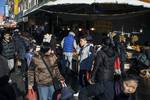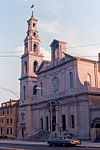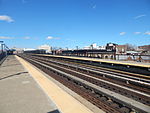Bocchino-Dente Memorial Plaza
Bocchino-Dente Memorial Plaza is a 0.853-acre plaza located at the intersection of Fort Hamilton Parkway, 58th Street and 10th Avenue in the Borough Park section of Brooklyn, New York. The neighborhood's streets were laid out in a grid of streets and avenues at the turn of the 20th century while Fort Hamilton Parkway cuts diagonally through the grid on its route between Prospect Park and Bay Ridge. Triangular intersections that were too small to be developed were designated as public plazas, including this one. The plaza adjoins the school yard of Public School 105 The Blythebourne School, which carries the old name of Borough Park. In 1952, local City Councilman Arthur A. Low sponsored legislation to designate this triangle as the Bocchino-Dente Memorial Plaza in honor of local residents John Bocchino and Alfred Dente, who had been killed in the Second World War. The renaming was supported by the local post of the American Legion which carried the name Bocchino-Dente Post 1777. The local law to designate this plaza with this name was enacted on May 15, 1952 after the signature of the mayor of New York.
Excerpt from the Wikipedia article Bocchino-Dente Memorial Plaza (License: CC BY-SA 3.0, Authors).Bocchino-Dente Memorial Plaza
58th Street, New York Brooklyn
Geographical coordinates (GPS) Address Nearby Places Show on map
Geographical coordinates (GPS)
| Latitude | Longitude |
|---|---|
| N 40.6338 ° | E -74.0036 ° |
Address
58th Street 1011
11219 New York, Brooklyn
New York, United States
Open on Google Maps









